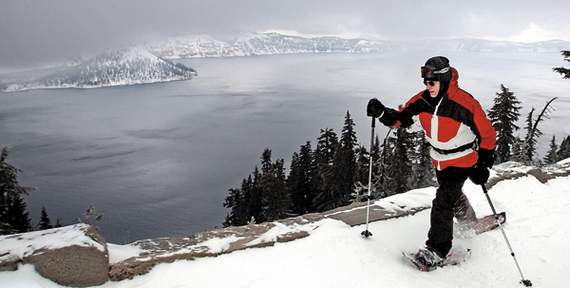Gorgeous and Free: free, guided snowshoe hikes have been offered at Crater Lake National Park for almost 30 years
Mail Tribune
Medford, Oregon
December 27, 2007
BY SARAH LEMON
 |
| Above: Larry Oppert of Klamath Falls snowshoes at snowy Crater Lake. Inset: Crater Lake National Park Ranger Don Clark guides a group of park visitors on a free snowshoe hike. Photo by Jamie Lusch |
Both newly single, Pat Wafer and Pam Frank came to Crater Lake looking for an adventure.
What they got was a guided tour through winter’s realm with lessons in ecology and natural history — all for the cost of gasoline to drive from Roseburg.
|
IF YOU GO |
| What: Free, guided snowshoe hikes at Crater Lake (snowshoes provided). Moderately strenuous hike covers approximately 1 mile of terrain at about 7,100 feet. Participants should be at least 8 years old and dress warmly. When: 1 p.m. weekends through April; weekdays for groups with advance reservations. Where: Visitors center at Crater Lake National Park.For more information and reservations: Call 541-594-3100 on weekends, 541-594-3093 for weekday, group reservations. |
“This is one of the better deals because you don’t have to pay to get into the park in winter,” says National Park Service Ranger Don Clark.
Free snowshoe hikes introduce Crater Lake visitors to the park’s true colors — winter white and slate gray — every weekend through April. This may be the off-season for tourists, but it’s Crater Lake’s dominant season, characterized by some 45 feet of snow, the last of which sticks around until June.
“This is a way to let people explore the park … when our hiking trails are buried by snow, our roads are buried by snow,” says National Park Service Ranger David Grimes.
Wafer, 50, and Frank, 46, both of Roseburg, are among the majority of participants who have never snowshoed. Against a biting wind wailing around Rim Village, the two struggle to cinch up their straps. Wafer thinks better of going hatless, while Frank bums a pair of mittens off Clark.
“If you can walk, you can do snowshoes,” the ranger reassures them. “The hardest part is putting the snowshoes on.”
If you want to throw a snowball, the ranger tells the group, throw a snowball — just not at him. However, horsing around doesn’t seem likely as the nine hikers hunch against the howling blast, tears springing to their eyes. The 1-mile route suddenly seems too long.
But just a few hundred feet past the parking lot in the first copse of trees, the gusts become a gentle breeze. The landscape, like the people, must be patient and flexible, Clark says.
“What we are dealing with are the forces of winter.”
Clark demonstrates how a mountain hemlock will lie so low under the weight of snow and force of wind that it’s just a few degrees from horizontal. The star-shaped branches of the Shasta red fir prevent the majority of snowflakes from sticking, he says. It’s for good reason that the park’s host of tree species includes 14 evergreens compared with just two deciduous.
“They told you this snowshoe hike was free, but it’s not; you have to listen to me,” Clark jokes.
The program is the weekend version of “classroom at Crater Lake,” which acquaints fourth- and fifth-graders with the natural wonder, Grimes says. Because snowshoes don’t damage vegetation, visitors can tread in areas which are susceptible to erosion in summer, he says. The snowshoe hikes — organized in some form for almost 30 years — are open to groups on weekdays by advance reservation, Grimes says.
The lecture’s scope depends on the ranger in charge, Grimes says, but could include some history of snowshoeing, or anecdotes about the first vehicle traffic through the park in 1906. Rangers often encourage hikers to join them afterward for a cup of cocoa in the Rim Village cafe.
The next hour and a half with Clark brings discussion of animal migration, hibernation and adaptation to the conditions; the short course on Crater Lake’s volcanic origins and, finally, the breathless moment when its serene waters come into view.
“It’s the world champion for clarity for big, deep lakes,” Clark says, explaining the snow’s role in replenishing and cleansing the caldera’s contents. The lake last froze in 1949, he adds.
The group can hardly stand still as Clark mentions the sight of several animal tracks, so eager are they to reach the lake. Numb feet nimbly tackle the next hill. Hands that were once too cold to pull from pockets clench cameras.
Posing for snapshots, Stanford geology students Mark Riedel, 31, and Shauna Riedel, 26, have finally laid eyes on her proposed research subject. Even though Crater Lake proved too studied for an academic paper, the couple planned their vacation around a wintertime visit.
“It was awesome,” Shauna Riedel says. “I can’t believe you don’t have to pay.”
Other pages in this section

